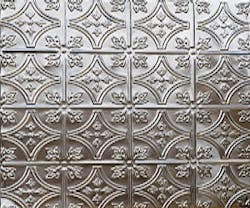Tips for Maintaining and Replacing Ceiling Tiles
Ceiling tiles in commercial buildings are low maintenance and long lasting, which can also mean that they're rarely noticed and mostly forgotten. If you haven't thought about your ceiling tiles in a while, it's time for a refresher course. Use the following tips for inspecting, maintaining, and replacing your tiles.
Assessments
When performing routine ceiling inspections, check for tile discoloration or warping. "Ceiling tile will become stained due to water leaking from above, or it will discolor due to environmental factors, like ultraviolet lighting," says Curt Stemmerich, owner of Trafford, PA-based Preserve A Ceiling. Discoloration is part of the aging process for ceiling tiles, and acoustic value and fire rating are also affected.
Aside from aging, Jeremy Verstraete, product manager, ceilings division, at Chicago-based USG Corp., cites a few other reasons to change your tiles, including damage, aesthetic improvement, compliance with regulations, and performance improvement. Bill Reed, owner of Interior Floor to Ceiling Services LLC, Palmyra, NJ, adds that rusted, warped, or damaged grids also warrant repair and replacement.
Upkeep
As part of their preventive maintenance programs, facility managers should check ceiling tiles. Even if the tiles don't look dirty, they probably need to be cleaned. "Take a wet, damp cloth; apply a tiny bit of cleaner to it; and wipe the ceiling grid 6 inches. See how much dirt is on the non-absorbing grid. The porous tiles are much worse," says Reed. "They hold a lot more dirt than the grid, and they're a breeding ground for mold, germs, bacteria, and dust mites." Keep air quality good by using a soft sweep broom or a non-solvent-based commercial cleaner on the tiles.
"Keep the ductwork clean," adds Stemmerich, "and clean outside air diffusers." Verstraete recommends immediately removing any corrosive substances (like wallpaper adhesive) that could attack painted finishes, and looking at the tile for visible damage. "Touch up all minor scratches and spots," says Verstraete, "or replace damaged sections when touch-up isn't possible."
Replacement
If it's time to replace a few (or all) of your ceiling tiles, make sure the pattern you've been using is still available. Reed recommends ordering as many replacement tiles as you need, plus an additional 2 percent of the total amount. "They come in handy when tiles get ruined for whatever reason - water leaks, workers, etc. The older the tiles get, the harder it will be to match them, although some manufacturers guarantee to produce certain tiles for 10 years," says Reed.
You should also step back and look at the work you've done. "When you replace individual tiles, and they're noticeably whiter, you may want to replace or restore the surrounding tiles, unless you don't mind the checkerboard look," says Stemmerich.
Verstraete says that improper installation can also cause a checkerboard look: "Some tiles are required to be installed in a certain direction to avoid the checkerboard effect," he says. "Look for directional arrows on existing tile, and install the news ones in a similar fashion."
Jenna M. Aker ([email protected]) is associate editor at Buildings magazine.
